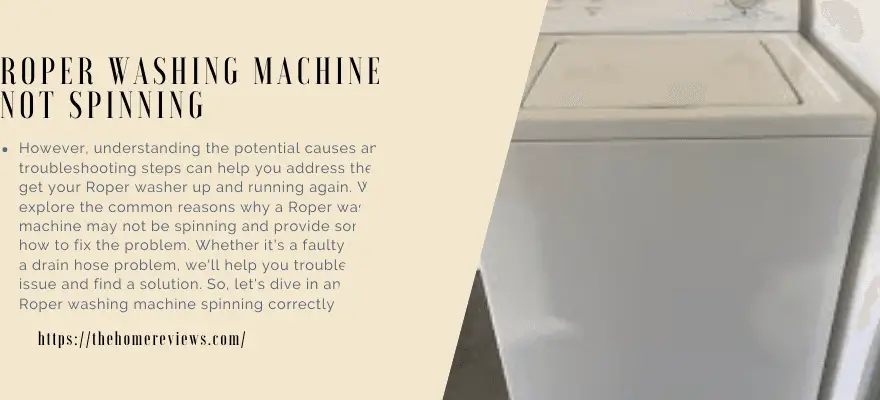
If your Roper washing machine is not spinning, the most likely cause is a displaced or faulty spin switch. This small switch should be pressed down by the lid when it’s closed to initiate the spin cycle.
To troubleshoot, try holding the switch down with your finger (with the lid open) and starting a spin cycle. If the machine spins with the switch held down, it indicates that the switch needs to be repaired or replaced. Having a washing machine that isn’t spinning can be a frustrating problem to deal with.
However, understanding the potential causes and troubleshooting steps can help you address the issue and get your Roper washer up and running again. We will explore the common reasons why a Roper washing machine may not be spinning and provide some tips on how to fix the problem. Whether it’s a faulty spin switch or a drain hose problem, we’ll help you troubleshoot the issue and find a solution. So, let’s dive in and get your Roper washing machine spinning correctly again.
Common Causes Of Roper Washing Machine Not Spinning
If you’re dealing with a Roper washing machine that refuses to spin, you’re not alone. A washing machine that doesn’t perform its primary function can be a source of frustration and inconvenience. However, before you call in a repair technician, there are several common causes of a Roper washing machine not spinning that you can troubleshoot on your own. In this article, we’ll explore these issues and provide tips on how to resolve them.
- Load Imbalance
One of the most common reasons for a Roper washing machine not spinning is an uneven load. If your laundry is clumped to one side or if the machine is overloaded, it can become unbalanced. When this happens, the machine’s sensors may prevent it from spinning to avoid potential damage. To address this issue, open the machine, redistribute the load evenly, and try again. - Lid Switch Malfunction
The lid switch is a safety feature designed to prevent the washing machine from spinning when the lid is open. If this switch is malfunctioning, the machine might think the lid is open, even when it’s closed. To test this, listen for a clicking sound when you close the lid. If you don’t hear it, the lid switch might need to be replaced. - Drive Belt Issues
A worn or broken drive belt can also lead to a Roper washing machine’s spinning problem. To check the drive belt, unplug the machine and remove the back panel. If you notice that the belt is loose or damaged, it should be replaced. Make sure to consult your owner’s manual for specific instructions on how to replace the drive belt for your particular Roper model. - Motor Coupling Failure
The motor coupling connects the motor to the transmission and enables the drum to spin. Over time, this part can wear out or break, causing the machine to stop spinning. You might hear a rattling noise when this occurs. Replacing the motor coupling is a bit more complex and may require the help of a professional technician. - Clogged Drain Pump or Hose
If the machine is unable to drain properly, it may not spin. Check for clogs in the drain pump or hose. You can usually access these components from the front or bottom of the machine. Clean out any debris, and the spinning issue might be resolved. - Faulty Motor
In some cases, a faulty motor can be the culprit. If you don’t hear any motor noise when the machine should be spinning, it might be time for a motor replacement. This is a more complex and costly repair, so it’s best left to a qualified technician. - Control Board Problems
Issues with the control board or other electronic components can also lead to spinning problems. Check for error codes or unusual behavior on the display panel. Sometimes, a simple reset or control board replacement can fix the issue. - Bearing Wear
If you hear loud, rumbling noises during the spin cycle, worn-out drum bearings may be the issue. Replacing these bearings is a complex task and is typically best left to professionals. - Suspension Springs and Shocks
The suspension springs and shocks help stabilize the drum during the spin cycle. If they are broken or worn out, the machine may not spin correctly. Inspect these components and replace them if needed.
In conclusion, a Roper washing machine not spinning can result from various issues, some of which you can troubleshoot and fix on your own. However, for complex problems or if you’re uncertain about any repair, it’s advisable to seek the assistance of a qualified technician. Regular maintenance and addressing issues promptly can help keep your Roper washing machine in good working condition, ensuring that it continues to serve you effectively.
Check The Spin Switch
If your Roper washing machine is not spinning, check the spin switch. A displaced or faulty spin switch could prevent the spin cycle from starting. Troubleshoot by holding the switch down with your finger and starting a spin cycle with the lid open.
On the bottom of the machine, it may indicate a problem with the spin switch. Here’s how you can check if the spin switch is causing your Roper washing machine not to spin:
Ensure The Lid Is Properly Closed To Press Down The Spin Switch
- Make sure that the lid of your Roper washing machine is securely closed. The spin switch is designed to be pressed down by the lid, allowing the machine to enter the spin cycle. If the lid is not closed properly, the spin switch may not be activated, preventing the machine from spinning.
Hold The Switch Down With Your Finger And Start A Spin Cycle
- With the lid open, locate the spin switch in your Roper washing machine. It is usually located near the lid hinge or on the side of the machine’s interior.
- Use your finger to hold the spin switch down firmly. While holding it down, start a spin cycle on your machine.
- If the machine starts spinning with the spin switch held down, it indicates that the switch is not being activated properly by the lid. In such cases, you may need to adjust or replace the lid or the spin switch itself.
Remember, always exercise caution when working with electrical appliances. If you’re unsure or uncomfortable performing any troubleshooting or repairs, it’s best to consult a professional technician to avoid any potential safety hazards.
By checking the spin switch in your Roper washing machine, you may be able to identify and resolve the issue of it not spinning. However, if the problem persists, it is recommended to seek professional assistance to ensure a proper diagnosis and repair.
Inspect The Drain Pump
Inspect the drain pump to troubleshoot a Roper washing machine that is not spinning. This step can help determine if there is a clog or issue with the pump that is preventing proper spinning.
When your Roper washing machine is not spinning, one of the possible causes could be a problem with the drain pump. The drain pump is responsible for draining the water from the machine during the spin cycle. If it is clogged or damaged, it can prevent the machine from spinning properly.
Here are a few steps you can take to inspect the drain pump:
- Clean out any debris or obstructions in the drain pump. Over time, debris such as lint, coins, or small objects can accumulate in the drain pump, leading to a blockage. To clean it out, follow these steps:
- Unplug the washing machine and locate the drain pump. It is usually located at the bottom of the machine.
- Remove any hoses or connections attached to the drain pump.
- Use a screwdriver or pliers to remove the pump cover and access the inside.
- Carefully remove any debris or obstructions that you find. Be cautious not to damage any parts.
- Once the pump is clean, reassemble everything and test the machine to see if it spins properly.
- Check for any signs of damage or malfunction. Inspect the drain pump for any visible signs of damage, such as cracks or leaks.
- If you notice any damage, you may need to replace the drain pump. Contact a professional technician or reference the washing machine’s manual for guidance on how to do this.
- Additionally, check if the pump is running smoothly and not making any unusual noises. A malfunctioning pump can also affect the machine’s spinning ability.
By inspecting the drain pump and addressing any issues, you can troubleshoot and potentially resolve the problem of your Roper washing machine not spinning.
Examine The Motor
If your Roper washing machine is not spinning, it may be due to a faulty motor. To examine the motor, check for any signs of damage or malfunction. If necessary, replace the motor to ensure proper spinning functionality.
If your Roper washing machine is not spinning, one of the possible culprits could be a faulty motor. The motor is responsible for powering the spinning motion of the drum, so it’s important to examine it for any faults or malfunctions. Here are some steps you can take to test and replace the motor if necessary:
Test the motor for any faults or malfunctions:
- Check for power supply: Ensure that the washing machine is properly connected to a power source and that the circuit breaker has not tripped. If there is no power supply, the motor will not function.
- Inspect for any visible damage. Visually examine the motor for any signs of damage, such as frayed wires, burned components, or loose connections. These issues can cause the motor to malfunction.
- Test with a multimeter: Use a multimeter to check the continuity of the motor’s wiring. Set the multimeter to resistance or continuity mode, and touch the meter’s probes to the motor’s terminals. If there is no continuity, it indicates a problem with the motor.
- Listen for unusual noises: Turn on the washing machine and listen for any unusual noises coming from the motor. Grinding, squealing, or buzzing sounds could indicate a faulty motor.
Replace the motor if necessary.
- Disconnect power: Before replacing the motor, make sure to disconnect the power supply to the washing machine. This ensures your safety during the procedure.
- Remove the old motor. Open the washing machine’s housing to access the motor. Disconnect the wiring harness and any mounting brackets holding the motor in place. Carefully remove the old motor from the washing machine.
- Install the new motor. Place the new motor in the same location as the old one and secure it with mounting brackets. Connect the wiring harness to the new motor according to the manufacturer’s instructions.
- Test the new motor: Once the new motor is installed, reconnect the power supply and run a test cycle to ensure that the washing machine is spinning smoothly.
By following these steps, you can diagnose and address any issues with the motor of your Roper washing machine. If the problem persists even after replacing the motor, it may be best to consult a professional technician for further assistance.
Check The Belt And Pulley
If your Roper washing machine is not spinning, check the belt and pulley. A worn or broken belt or a faulty pulley could be the cause of the problem. Replace any damaged parts to get your machine spinning again.
Inspect the belt for any signs of wear or damage.
- Check the belt for cracks, fraying, or stretching.
- Look for any signs of wear, such as visible damage or excessive slack.
- Ensure that the belt is properly aligned and centered on the pulley.
- Verify that the belt is tightly secured and not loose or slipping.
- If you notice any issues with the belt, it may need to be replaced.
Check the pulley for proper alignment and functionality.
- Ensure that the pulley is securely attached to the motor shaft.
- Make sure that the pulley spins freely without any resistance.
- Check for any signs of damage, such as cracks or wear.
- Ensure that the pulley is properly aligned with the belt.
- If the pulley is misaligned or damaged, it may need to be replaced to restore proper functionality.
Remember, if you’re unsure about inspecting the belt and pulley yourself, it’s always best to consult a professional technician for assistance. They can diagnose the issue and provide the necessary repairs or replacements to get your Roper washing machine spinning again.
Additional Tips And Tricks For Fixing A Roper Washing Machine Not Spinning
If your Roper washing machine is not spinning, it may be due to a faulty spin switch. Make sure the switch is pressed down by the lid when closed. If it’s still not spinning, check the drain hose tub seal and bearing for any issues.
Is your Roper washing machine not spinning? Don’t worry, we’ve got you covered. Here are some additional tips and tricks to help you troubleshoot and fix the issue:
- Clean the agitator to ensure it’s not obstructing the spinning motion. Over time, the agitator in your washing machine may become dirty or clogged, preventing it from spinning properly. To clean the agitator, remove any clothes from the machine and fill it with hot water. Add a cup of white vinegar or a mild detergent, then let the machine agitate for a few minutes. This will help break down any dirt or debris that may be causing the obstruction.
- Verify that the washer is properly leveled to prevent spinning issues. If your Roper washing machine is not properly leveled, it can cause the drum to become unbalanced during the spin cycle, resulting in the machine not spinning. To check if your washer is level, place a spirit level on top of the machine. If the bubble is not centered, adjust the machine’s adjustable feet until it is level. This simple step can often solve spinning issues.
- Consult the Roper washing machine manual for specific troubleshooting steps: Every washing machine model is unique, and the Roper washing machine is no different. If you’re still experiencing spinning issues after trying the above tips, it’s a good idea to consult the Roper washing machine manual for specific troubleshooting steps. The manual will provide you with detailed instructions on how to diagnose and fix common issues. Make sure to follow the manual carefully and safely.
Remember, fixing a Roper washing machine that’s not spinning may require some trial and error. If your attempts to fix the issue are unsuccessful, it’s best to reach out to a professional technician for further assistance. Happy troubleshooting!
Why Is My Washing Machine Not Spinning But Washing?
The most likely cause is a displaced or faulty spin switch. To troubleshoot, press down the switch with your finger and start a spin cycle.
How do you fix a washing machine that won’t agitate or spin?
To fix a washing machine that won’t agitate or spin, check the spin switch to ensure it’s pressed down when the lid is closed. If it’s not, hold it down with your finger and start a spin cycle. Additionally, check the drain hose for clogs, kinks, or incorrect positioning, as this may prevent proper spinning.
If these steps don’t resolve the issue, professional repair may be necessary.
Why Does My Roper Washing Machine Make Noise When Spinning?
A noisy Roper washing machine during the spin cycle could be due to a defective tub seal and bearing. Replacing this requires extensive repair work.
Why Is My Whirlpool Washer Not Spinning Water Out Of Clothes?
If your Whirlpool washer is not spinning water out of clothes, the most likely issue is a problem with the drain hose. It could be clogged, kinked, or positioned incorrectly. Check the drain hose for any blockages or restrictions.
Why Is My Roper Washing Machine Not Spinning?
If your Roper washing machine is not spinning, it could be due to a faulty spin switch or safety measure. Troubleshoot by holding the switch down and starting a spin cycle.
Conclusion
If your Roper washing machine is not spinning, there are a few potential causes to consider. One common issue is a displaced or faulty spin switch. This switch should be pressed down by the lid when it’s closed, and if it’s not, the machine may prevent the spin cycle as a safety measure.
You can troubleshoot this by holding the switch down with your finger (with the lid open) and starting a spin cycle. Another possible culprit is a drain hose problem. If the washer spins but still leaves clothes soaked, the drain hose could be clogged, kinked, or positioned incorrectly.
Additionally, a noisy spin cycle or leaking near the transmission may indicate a defective tub seal and bearing. Ultimately, it’s important to address these issues promptly to ensure your Roper washing machine functions properly. By troubleshooting and addressing the specific cause of the problem, you can get your machine back to spinning effectively and successfully complete your laundry tasks.





